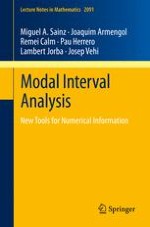This book presents an innovative new approach to interval analysis. Modal Interval Analysis (MIA) is an attempt to go beyond the limitations of classic intervals in terms of their structural, algebraic and logical features. The starting point of MIA is quite simple: It consists in defining a modal interval that attaches a quantifier to a classical interval and in introducing the basic relation of inclusion between modal intervals through the inclusion of the sets of predicates they accept. This modal approach introduces interval extensions of the real continuous functions, identifies equivalences between logical formulas and interval inclusions, and provides the semantic theorems that justify these equivalences, along with guidelines for arriving at these inclusions. Applications of these equivalences in different areas illustrate the obtained results. The book also presents a new interval object: marks, which aspire to be a new form of numerical treatment of errors in measurements and computations.
